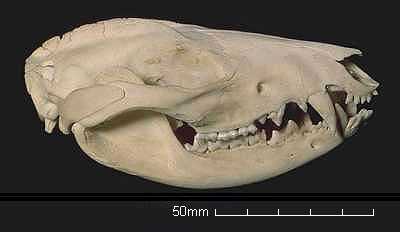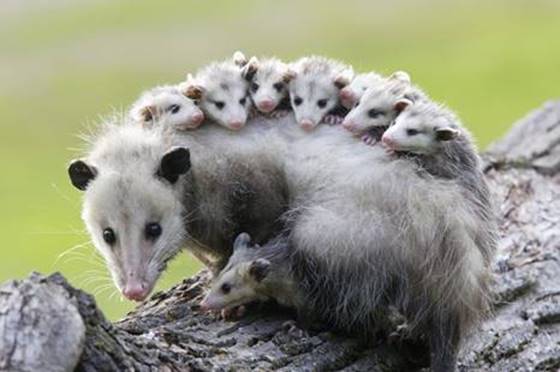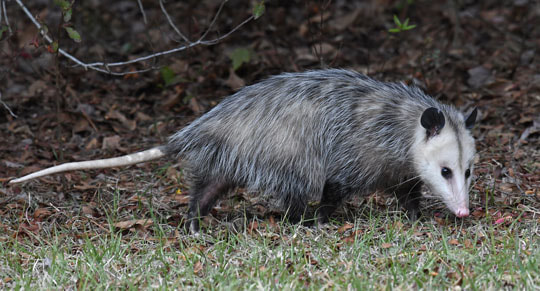Since when did they change it to opossum? When I was comin’ up it was just possum. Opossum makes it sound like he’s Irish or something. Why do they gotta go changing everything? – Jesse Pinkman, Breaking Bad.
The opossum is a marsupial and the only one present in North America. The species is thought to have originated in South America and made its way north during the Great American Interchange when, during the Cenozoic, the volcanic Isthmus of Panama rose from the seafloor to connect the previously separate continents.
Marsupials, including kangaroos, wallabies, koalas and others, give birth to relatively undeveloped young that make their way to their mother’s pouch to further develop. The term marsupial comes from marsupium, the technical term for the abdominal pouch, derived from the Greek marsippos – pouch. Didelphis – Greek Di – two, and Delphis – womb. I assume meaning the womb and the pouch.
The word opossum appears to be derived from the Powhatan Native American language of the east coast of the U.S. John Smith, a founder of Jamestown, and William Strachey both noted the species between 1607 and 1611. Strachey describes the opossum as “…a beast in bigness of a pig and in taste alike”. The Powhatan word means “white dog or dog-like beast”.
The species is quite widespread ranging from southern Ontario and B.C. through much of the U.S. and Mexico to northwestern Costa Rica. During European settlement opossums were only found as far north as northern Ohio and northern West Virginia. Since then the species range has increased into Canada. All occurrences in the U.S. and Canada west of the Great Plains and the Rocky Mountains are the result of transplants from the eastern U.S.
Adults can weigh up to 14 pounds but this size is attainable only by what is described by “fat, old individuals”. Total length is generally less than 30 inches, so about that of a medium sized cat. Opossums have a distinctive, conical shaped head, naked, leathery ears, with dense white fur with black tips – giving them a scraggly appearance. They typically have a white face.
You can easily identify an opossum skull because of the number of teeth – 50, more than any other mammal in North America. The skull is squeezed into a top sagittal crest, leaving limited space for a brain, which may explain the critter’s propensity for scurrying into traffic.

Breeding occurs in January and can extend through November, opossums can have two litters in a year. The number of young is limited by the number of nipples in the pouch. After birth the young, weighing only 0.5 ounces, find their way to the pouch where they latch onto a teat. Normally 13 teats are available and in a serious round of musical chairs, if you don’t get one in time, that’s it. The teat will swell, thus attaching the young to the mom as they develop. A litter of 8-9 appears to be average.
Because of their relatively undeveloped state it will take up to 70 days before the young venture out of the mom’s pouch to explore, often hitching a ride on her back. Weaning occurs at about 87 days. In captivity opossums have lived up to 4.5 years but is likely considerably less in the wild.

Opossums are quite an adaptable animal and can be found in forests, grassland, agricultural lands, and suburban habitats. The species is nocturnal and daytime dens include holes, cracks, and crevices in and under trees, stumps, hollow logs, hay stacks, vine tangles, rock outcrops, road culverts, attics and building foundations, beneath porches, and within piles of rock, brush, and debris.
Opossums will eat just about anything they come across, having a reputation for scavenging carrion and garbage. Their documented diet includes grass, maggots, mushrooms, earthworms, insects, other invertebrates, seeds, corn, crayfish, snakes, bird eggs, frogs, etc., etc. The most frequent place I’ve seen them in my neighborhood is lurking around the dumpster behind the local grocery store.
Opossums are known to “play dead” when disturbed, thus the term “playing possum”. This is not a voluntary action but an autonomic response to a threat. The opossum falls on its side and lies still with the body slightly flexed. The corners of the mouth are drawn back and the mouth produces quite a bit of drool. They will often defecate and discharge a foul smelling substance from its anal gland. The eyes remain open and sometimes the ears twitch. Left along they will recover in half an hour to a couple hours.
The act is quite convincing. Working as a fish ecologist in Pennsylvania I had to regularly check a remote continuous water monitoring station for temperature and dissolved oxygen along the Susquehanna River. The access was through a gated forest road that extended about a mile. Once while driving down the road I noticed a juvenile opossum in the road. I got out, poked it a bit, picked it up and watch for breath. Nothing.
Even though I knew that opossums play dead I was convinced, yes, that this one had been injured and died. I left it in the middle of the forest road and went on my way. About 40 minutes later on my return trip I stopped at the same spot and yep – the opossum had fooled me and was gone.
In graduate school one of my friends was studying rabbits so I’d help him with his trapping and he would help with mine. Every once in a while we would get an opossum in the live trap and figured, well, we might as well give them an ear tag as well and track the data. When cornered opossums will give an intimidating hiss – so we would use gloves when tagging them. But eventually it became clear that the hiss was a big front and they would never bite. So we dispensed with the gloves, pulled them out of the trap by their tails, gave them a quick ear tag and let them go.
Armed with this knowledge I came across an opossum scurrying around the QFC parking lot early on weekend morning so I made a quick dart and caught him by the tail and just lifted him up. He hissed and then just kind of went limp, staring at me with those beady eyes. It took a minute before I noticed the elderly woman across the parking lot who had got out of the car and was watching us in a state of alarm. I waved, put down my catch, and we both watched it scurry across the street.
And lastly, I was walking around Green Lake in Seattle on a sunny afternoon as any number of adults, kids, dogs, and baby strollers were traveling in the opposite direction. I abruptly stopped my conversation with my companion and said – “Wait a minute” and quickly turned around to catch up with the woman with a stroller who had just walked past us. “Excuse me” I said as I caught up to her, “…but do you have an opossum in that stroller?”. “Why yes I do!” she proudly exclaimed. It was her pet and was sitting upright in the stroller, outfitted in a lovely print dress and matching bonnet. Both were out for an afternoon stroll.
